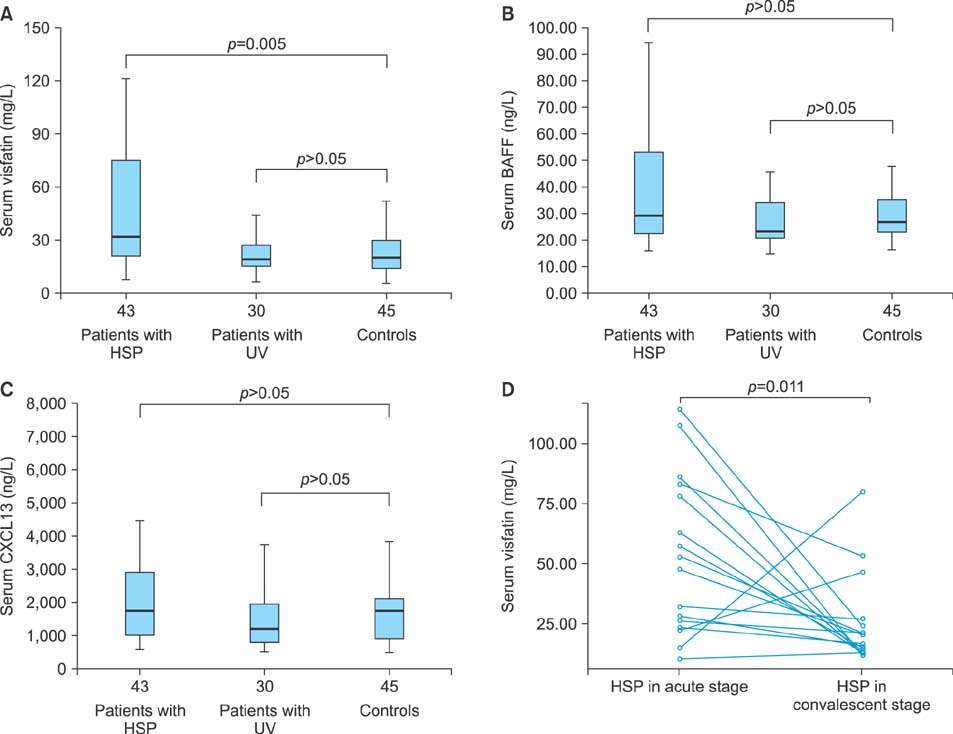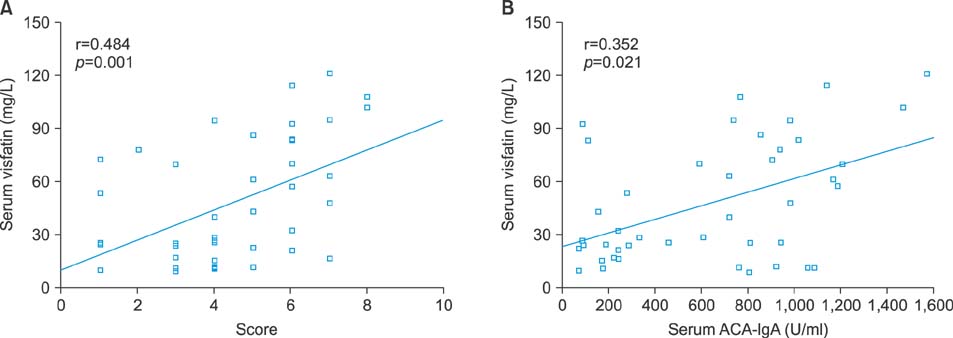Ann Dermatol.
2014 Jun;26(3):303-307.
Elevated Serum Levels of Visfatin in Patients with Henoch-Schonlein Purpura
- Affiliations
-
- 1Department of Dermatovenereology, West China Hospital of Sichuan University, Chengdu, Sichuan, China. guozp930@163.com
Abstract
- BACKGROUND
Henoch-Schonlein purpura (HSP) is an immune complex-mediated disease predominantly characterized by the deposition of circulating immune complexes containing immunoglobulin A (IgA) on the walls of small vessels. Although the pathogenesis of HSP is not yet fully understood, some researchers proposed that B-cell activation might play a critical role in the development of this disease.
OBJECTIVE
To investigate the serum levels of visfatin (pre-B-cell colony-enhancing factor), B-cell-activating factor (BAFF), and CXCL13, and to analyze their association with disease severity.
METHODS
The serum levels of visfatin, BAFF, and CXCL13 were measured by using a double-antibody sandwich enzyme-linked immunosorbent assay (ELISA) in 43 patients with HSP and 45 controls. The serum levels of IgA anticardiolipin antibodies (ACA) were detected by using a double-antigen sandwich ELISA.
RESULTS
Levels of visfatin but not BAFF and CXCL13 were significantly elevated in the sera of patients with HSP in the acute stage, and restored to normal levels in the convalescent stage. Furthermore, serum levels of visfatin were significantly higher in patients with HSP having renal involvement than in those without renal involvement. Serum levels of visfatin were correlated with the severity of HSP and serum concentration of ACA-IgA.
CONCLUSION
We show for the first time that the serum levels of visfatin are abnormally elevated in patients with HSP. Visfatin may be associated with the pathogenesis of HSP.
Keyword
MeSH Terms
-
Antibodies, Anticardiolipin
Antigen-Antibody Complex
B-Cell Activating Factor
B-Lymphocytes
Chemokine CXCL13
Enzyme-Linked Immunosorbent Assay
Humans
Immunoglobulin A
Nicotinamide Phosphoribosyltransferase*
Purpura, Schoenlein-Henoch*
Antibodies, Anticardiolipin
Antigen-Antibody Complex
B-Cell Activating Factor
Chemokine CXCL13
Immunoglobulin A
Nicotinamide Phosphoribosyltransferase
Figure
Reference
-
1. Linskey KR, Kroshinsky D, Mihm MC Jr, Hoang MP. Immunoglobulin-A--associated small-vessel vasculitis: a 10-year experience at the Massachusetts General Hospital. J Am Acad Dermatol. 2012; 66:813–822.
Article2. Beale MG, Nash GS, Bertovich MJ, MacDermott RP. Similar disturbances in B cell activity and regulatory T cell function in Henoch-Schönlein purpura and systemic lupus erythematosus. J Immunol. 1982; 128:486–491.3. Donnithorne KJ, Atkinson TP, Hinze CH, Nogueira JB, Saeed SA, Askenazi DJ, et al. Rituximab therapy for severe refractory chronic Henoch-Schönlein purpura. J Pediatr. 2009; 155:136–139.
Article4. Böttner M, Laaff M, Schechinger B, Rappold G, Unsicker K, Suter-Crazzolara C. Characterization of the rat, mouse, and human genes of growth/differentiation factor-15/macrophage inhibiting cytokine-1 (GDF-15/MIC-1). Gene. 1999; 237:105–111.
Article5. Ding Q, Mracek T, Gonzalez-Muniesa P, Kos K, Wilding J, Trayhurn P, et al. Identification of macrophage inhibitory cytokine-1 in adipose tissue and its secretion as an adipokine by human adipocytes. Endocrinology. 2009; 150:1688–1696.
Article6. Luk T, Malam Z, Marshall JC. Pre-B cell colony-enhancing factor (PBEF)/visfatin: a novel mediator of innate immunity. J Leukoc Biol. 2008; 83:804–816.
Article7. Nickel N, Jonigk D, Kempf T, Bockmeyer CL, Maegel L, Rische J, et al. GDF-15 is abundantly expressed in plexiform lesions in patients with pulmonary arterial hypertension and affects proliferation and apoptosis of pulmonary endothelial cells. Respir Res. 2011; 12:62.
Article8. Otero M, Lago R, Gomez R, Lago F, Dieguez C, Gómez-Reino JJ, et al. Changes in plasma levels of fat-derived hormones adiponectin, leptin, resistin and visfatin in patients with rheumatoid arthritis. Ann Rheum Dis. 2006; 65:1198–1201.
Article9. Chung CP, Long AG, Solus JF, Rho YH, Oeser A, Raggi P, et al. Adipocytokines in systemic lupus erythematosus: relationship to inflammation, insulin resistance and coronary atherosclerosis. Lupus. 2009; 18:799–806.
Article10. Mackay F, Schneider P. Cracking the BAFF code. Nat Rev Immunol. 2009; 9:491–502.
Article11. Ragheb S, Lisak RP. B-cell-activating factor and autoimmune myasthenia gravis. Autoimmune Dis. 2011; 2011:939520.
Article12. Khare SD, Sarosi I, Xia XZ, McCabe S, Miner K, Solovyev I, et al. Severe B cell hyperplasia and autoimmune disease in TALL-1 transgenic mice. Proc Natl Acad Sci U S A. 2000; 97:3370–3375.
Article13. Shiao YM, Lee CC, Hsu YH, Huang SF, Lin CY, Li LH, et al. Ectopic and high CXCL13 chemokine expression in myasthenia gravis with thymic lymphoid hyperplasia. J Neuroimmunol. 2010; 221:101–106.
Article14. Yang YH, Huang YH, Lin YL, Wang LC, Chuang YH, Yu HH, et al. Circulating IgA from acute stage of childhood Henoch-Schönlein purpura can enhance endothelial interleukin (IL)-8 production through MEK/ERK signalling pathway. Clin Exp Immunol. 2006; 144:247–253.
Article15. Mills JA, Michel BA, Bloch DA, Calabrese LH, Hunder GG, Arend WP, et al. The American College of Rheumatology 1990 criteria for the classification of Henoch-Schönlein purpura. Arthritis Rheum. 1990; 33:1114–1121.
Article16. McDuffie FC, Sams WM Jr, Maldonado JE, Andreini PH, Conn DL, Samayoa EA. Hypocomplementemia with cutaneous vasculitis and arthritis. Possible immune complex syndrome. Mayo Clin Proc. 1973; 48:340–348.17. Chen T, Guo ZP, Zhang YH, Gao Y, Liu HJ, Li JY. Elevated serum heme oxygenase-1 and insulin-like growth factor-1 levels in patients with Henoch-Schonlein purpura. Rheumatol Int. 2011; 31:321–326.
Article18. Wang J, Zhang QY, Chen YX. Effects of Astragalus membranaceus on cytokine secretion of peripheral dendritic cells in children with Henoch-Schonlein purpura in the acute phase. Zhongguo Zhong Xi Yi Jie He Za Zhi. 2009; 29:794–797.19. Yang YH, Lai HJ, Huang CM, Wang LC, Lin YT, Chiang BL. Sera from children with active Henoch-Schönlein purpura can enhance the production of interleukin 8 by human umbilical venous endothelial cells. Ann Rheum Dis. 2004; 63:1511–1513.
Article20. Wisnieski JJ. Urticarial vasculitis. Curr Opin Rheumatol. 2000; 12:24–31.
Article21. Senolt L, Kryštůfková O, Hulejová H, Kuklová M, Filková M, Cerezo LA, et al. The level of serum visfatin (PBEF) is associated with total number of B cells in patients with rheumatoid arthritis and decreases following B cell depletion therapy. Cytokine. 2011; 55:116–121.
Article
- Full Text Links
- Actions
-
Cited
- CITED
-
- Close
- Share
- Similar articles
-
- Clinical Study on Henoch-Schonlein Purpura
- A Case of Henoch-Schonlein Purpura after Abdominal Blunt Trauma
- Henoch-Schonlein Purpura, Allergic Purpura, Anaphylactoid Purpura
- Small Intestinal Perforation as a Complication of Henoch-Schonlein Purpura
- Henoch-Schonlein Purpura in a Disseminated Tuberculosis Patient




